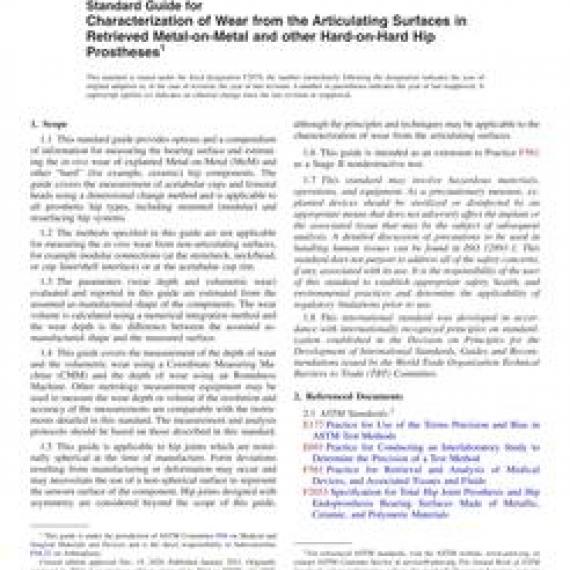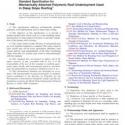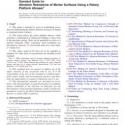No products
ASTM F2979-20
ASTM F2979-20 Standard Guide for Characterization of Wear from the Articulating Surfaces in Retrieved Metal-on-Metal and other Hard-on-Hard Hip Prostheses
standard by ASTM International, 12/15/2020
Full Description
1.1''This standard guide provides options and a compendium of information for measuring the bearing surface and estimating the in-vivo wear of explanted Metal-on-Metal (MoM) and other '''hard''' (for example, ceramic) hip components. The guide covers the measurement of acetabular cups and femoral heads using a dimensional change method and is applicable to all prosthetic hip types, including stemmed (modular) and resurfacing hip systems.
1.2''The methods specified in this guide are not applicable for measuring the in-vivo wear from non-articulating surfaces, for example modular connections (at the stem/neck, neck/head, or cup liner/shell interface) or at the acetabular cup rim.
1.3''The parameters (wear depth and volumetric wear) evaluated and reported in this guide are estimated from the assumed as-manufactured shape of the components. The wear volume is calculated using a numerical integration method and the wear depth is the difference between the assumed as-manufactured shape and the measured surface.
1.4''This guide covers the measurement of the depth of wear and the volumetric wear using a Coordinate Measuring Machine (CMM) and the depth of wear using an Roundness Machine. Other metrology measurement equipment may be used to measure the wear depth or volume if the resolution and accuracy of the measurements are comparable with the instruments detailed in this standard. The measurement and analysis protocols should be based on those described in this standard.
1.5''This guide is applicable to hip joints which are nominally spherical at the time of manufacture. Form deviations resulting from manufacturing or deformation may occur and may necessitate the use of a non-spherical surface to represent the unworn surface of the component. Hip joints designed with asymmetry are considered beyond the scope of this guide, although the principles and techniques may be applicable to the characterization of wear from the articulating surfaces.
1.6''This guide is intended as an extension to Practice F561 as a Stage II nondestructive test.
1.7''This standard may involve hazardous materials, operations, and equipment. As a precautionary measure, explanted devices should be sterilized or disinfected by an appropriate means that does not adversely affect the implant or the associated tissue that may be the subject of subsequent analysis. A detailed discussion of precautions to be used in handling human tissues can be found in ISO 12891-1. This standard does not purport to address all of the safety concerns, if any, associated with its use. It is the responsibility of the user of this standard to establish appropriate safety, health, and environmental practices and determine the applicability of regulatory limitations prior to use.
1.8''This international standard was developed in accordance with internationally recognized principles on standardization established in the Decision on Principles for the Development of International Standards, Guides and Recommendations issued by the World Trade Organization Technical Barriers to Trade (TBT) Committee.


































